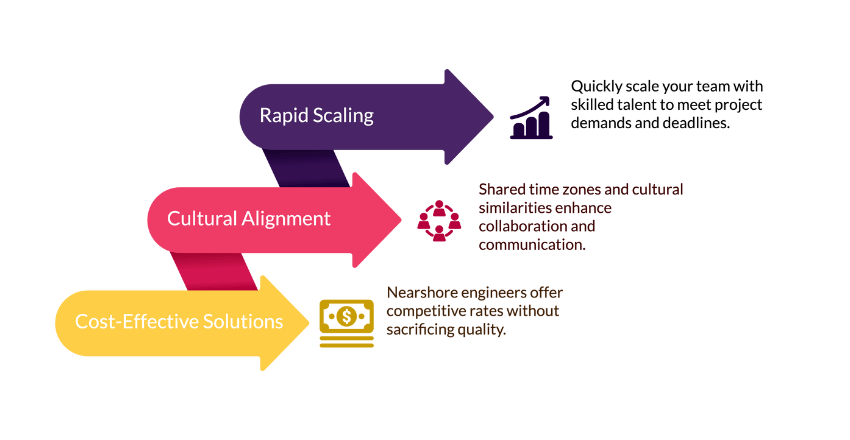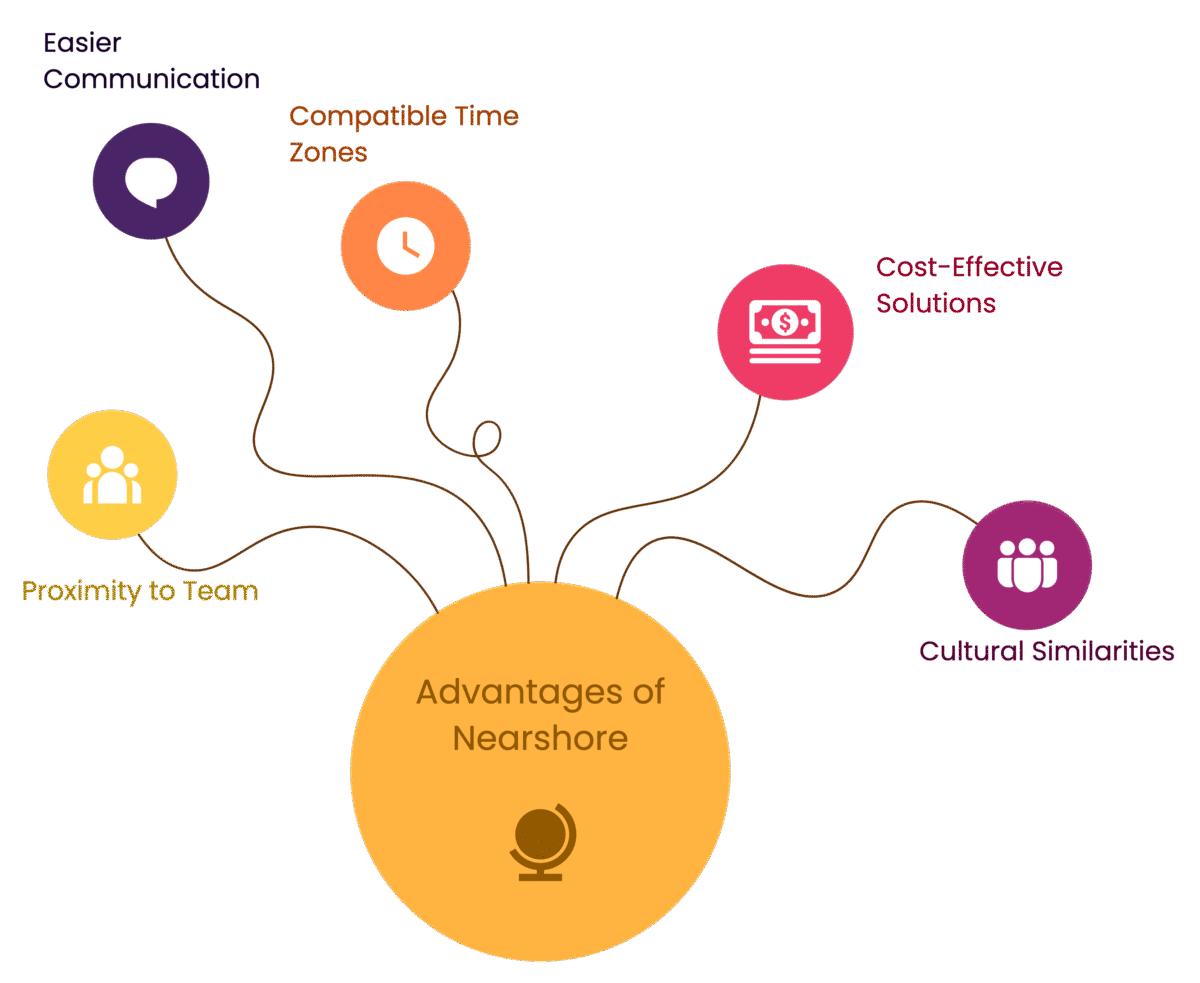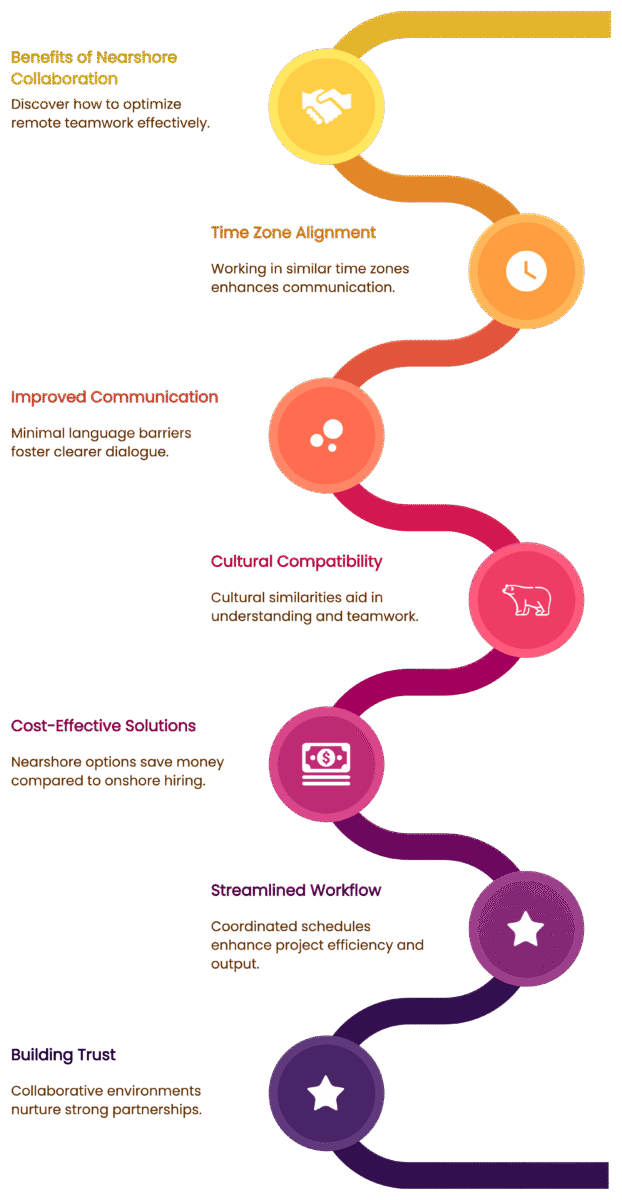
Better ROI on tech initiatives with nearshore engineers
When Laura became the CTO of a fast-growing fintech startup, she was brimming with ideas. The investors had poured millions into the company with high expectations for rapid innovation. Laura’s team had ambitious goals: redesign the user experience, enhance security features, and build a predictive analytics engine-all within a year.
Thank you for reading this post, don't forget to subscribe!At first, her team sprinted out of the gate, making solid progress. But by the third month, cracks began to show. Deadlines slipped, the budget strained, and her local engineers were stretched too thin. The pressure to deliver high-value features quickly became overwhelming. “We can’t keep up at this pace,” her lead developer told her during one tense meeting.
Laura needed help but couldn’t afford to double the size of her local team. Hiring more onshore developers at Silicon Valley rates wasn’t an option. She had to find a solution that balanced costs, talent, and time.
That’s when she discovered nearshore engineering.
A Practical Solution: Enter Nearshore Engineers

Nearshore engineers are professionals located in nearby countries with compatible time often includes engineers in Brazil and other nearby regions. Unlike outsourcing to distant regions where time zones and communication barriers can hinder progress, nearshore engineers offer a sweet spot between proximity and affordability.
Laura connected with a nearshore engineering firm based in Brazil. The firm’s engineers had impressive resumes, with experience working on similar fintech projects. They offered competitive rates, often half of what local engineers charged, without compromising on quality. But it wasn’t just about cost savings.
The engineers seamlessly integrated into Laura’s team, attending daily stand-ups, participating in code reviews, and collaborating with the product team. “It’s like they’re just down the street,” her project manager commented. And the results spoke for themselves-velocity increased, and previously delayed projects got back on track.
The True Cost of Delays vs. Investment in Talent
Delays in tech initiatives aren’t just inconvenient; they’re expensive and can have ripple effects across the entire business. Every missed deadline meant Laura’s company was not only losing potential revenue but also risking diminished trust from investors and clients. In fast-moving sectors like fintech, falling behind competitors can spell disaster. A customer frustrated by a lack of new features might switch to a rival platform, and that loss can be difficult to recover.
The pressure of constant delays began to take a toll on her team as well. Developers worked overtime to meet shifting deadlines, which led to growing frustration and burnout. Laura noticed that productivity was dropping and morale was at an all-time low. Retaining her top engineers became a growing concern as some began hinting at leaving for less stressful opportunities.
Laura knew that investing in talent was crucial to turning things around. Hiring nearshore engineers became a pivotal decision. This move allowed her to add skilled capacity without the high costs associated with local hiring. These engineers didn’t just contribute extra hands on deck; they brought fresh perspectives and technical expertise that helped accelerate key projects.
With this additional support, Laura’s team quickly regained momentum. They tackled the backlog of features and fixed long-standing issues that had previously slowed them down. Notably, the predictive analytics engine-a project that had been stagnating for months was finally completed ahead of schedule. The tool became a key talking point in investor pitches and even attracted new business partners.
The benefits went beyond faster delivery. The collaboration with nearshore engineers also allowed Laura’s internal team to focus on strategic initiatives rather than constantly firefighting. This balance restored a healthier work environment and gave her developers the breathing room to innovate.
Laura realized that investing in the right talent, even if it involved reallocating resources, provided a much stronger ROI than pushing her existing team to the brink. The cost of delays – from lost revenue to talent turnover – had been far greater than the upfront cost of expanding her workforce with nearshore talent. It was a lesson in the value of proactive investment over reactive crisis management.
Collaboration without the Headaches

When Laura first considered hiring nearshore engineers, communication challenges were her biggest concern. She had heard stories from other companies where offshore projects faltered due to language barriers, cultural misunderstandings, and mismatched time zones. The fear of delays and misalignment was enough to make her hesitate, despite her pressing need for additional development capacity.
However, her experience with the engineers from Brazil quickly turned those fears on their head. Communication flowed smoothly from the very start. Not only did her partners speak fluent English, but many were also proficient in both technical and business terminology, making discussions about complex projects much easier. Their bilingual expertise, particularly in Portuguese, also proved useful when collaborating with other stakeholders in Latin America. This expanded collaboration opened up further networking opportunities for the company.
Time zone compatibility was another major advantage. Being just a few hours ahead of her U.S. based team, the Brazilian engineers could actively participate in daily stand-ups, sprint reviews, and ad-hoc problem-solving sessions without anyone needing to adjust their schedules drastically. If an urgent issue came up, the team could jump on a video call immediately. This would have been far more difficult with engineers located in distant regions like Asia or Eastern Europe.
But effective communication went beyond just language and scheduling. Laura was struck by how seamlessly the nearshore engineers embraced her company’s agile practices. They did not require extensive training or onboarding to understand agile principles like iterative development, sprint planning, and continuous integration. They were already experienced with these methodologies and offered valuable suggestions to improve workflows. For example, during a sprint retrospective, one engineer proposed a method to streamline bug tracking that ended up saving hours each week.
The engineers were not content to be passive executors of assigned tasks. They brought fresh insights to the table, offering creative solutions to technical problems that Laura’s internal team had struggled with for months. This level of proactive engagement elevated them to trusted collaborators instead of mere contractors. “They’re not just coding what we tell them to. They are contributing real insights,” Laura observed with admiration.
This collaborative dynamic fostered a strong sense of partnership. By working together closely and sharing ideas freely, both teams became more aligned on goals and priorities. This alignment led to fewer misunderstandings, faster decision-making, and better outcomes. Enhanced trust and productivity drove a higher return on investment. Laura’s team could now focus on strategic initiatives while trusting that their nearshore partners had the capacity and expertise to handle core development tasks.
In the end, Laura realized that communication and collaboration with nearshore engineers could be as effective, if not more so, than with a fully on-site team. With the right partners in place, what had once seemed like a risky move became one of the most valuable decisions she had made as a CTO.
Measuring Success: ROI Beyond Dollars
By the end of the year, Laura presented her results to the board. Not only had the company hit its product milestones, but they had also come in under budget. Customer satisfaction scores increased, and new users flocked to the platform. The return on investment from hiring nearshore engineers extended beyond simple cost savings-it was about agility, innovation, and long-term growth.
Her story isn’t unique. Companies across industries are turning to nearshore engineering to supercharge their tech initiatives without breaking the bank. From startups to enterprises, the model offers a scalable way to boost productivity and reduce risk.
Is Nearshore Engineering Right for You?
If your tech team is struggling to meet deadlines or if your budget can’t support local hiring sprees, nearshore engineers might be the solution you need. Ask yourself:
- Could real-time collaboration with a cost-effective partner accelerate your roadmap?
- Are delays and overworked teams holding back your business goals?
Laura’s journey proved that with the right nearshore talent, you can deliver more without sacrificing quality.


